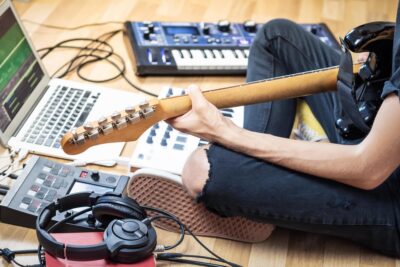Are you an aspiring guitarist looking for ways to practice without disturbing your neighbors or family members? One question that may have crossed your mind is, “Can you plug headphones into a guitar?” The good news is that the answer is yes.
By using the right equipment, you can enjoy the sound of your guitar through headphones, allowing for silent practice sessions. In this blog post, we’ll explore the different ways you can plug headphones into a guitar and the benefits of doing so.
What is a headphone jack?
A headphone jack is a small hole found on devices like smartphones, computers, and music players that allows you to connect your headphones or earphones to listen to audio. It’s usually a circular hole that’s about the same size as the headphone plug.
Once you insert your headphone plug into the jack, the audio signal is sent to your headphones, allowing you to hear the sound without the need for external speakers. Think of it as a tiny doorway that connects your headphones to your device and lets you enjoy your favorite music or podcasts privately.
Do all guitars have headphone jacks?
No, not all guitars have headphone jacks. In fact, most guitars don’t have built-in headphone jacks. However, there are some ways you can still use headphones with a guitar.
One option is to use a headphone amp, which is a small device that plugs into your guitar’s output jack and allows you to plug your headphones into the amp. Another option is to use a guitar effects processor that has a headphone output. These devices process the sound of your guitar and allow you to listen to it through headphones.
It’s important to note that some guitars, particularly electric guitars, may have a line-out jack or a headphone jack built into them. However, this is not common in all guitars.
So, while not all guitars have headphone jacks, there are other ways to use headphones with a guitar, such as using a headphone amp or a guitar effects processor.
What type of headphones can be plugged into a guitar?
The type of headphones that can be plugged into a guitar will depend on the equipment being used.
If you’re using a headphone amp, you can use any type of headphones that have a standard 1/4 inch or 3.5mm audio jack. Some headphone amps may also have additional features like a built-in equalizer or volume control, so be sure to check the specifications of your equipment.
If you’re using a guitar effects processor, you can also use any type of headphones that have a standard audio jack. However, some effects processors may have a specific impedance range, which is the resistance to the flow of electrical current. In this case, it’s important to use headphones that match the recommended impedance range to ensure optimal sound quality.
It’s worth noting that some headphones, such as noise-canceling headphones, may not be ideal for use with a guitar as they can alter the sound and affect your playing experience. In general, it’s best to use headphones that have a flat and neutral frequency response for the most accurate sound reproduction.
Can you damage your guitar by plugging in headphones?
No, plugging in headphones to your guitar will not damage your guitar. However, it’s important to use the right equipment to avoid any potential damage to your headphones or other gear.
If you’re using a headphone amp or effects processor, make sure that the output volume is set at a reasonable level to avoid any damage to your headphones or your ears. It’s also a good idea to start with a low volume and gradually increase it until you reach a comfortable listening level.
Another thing to consider is the type of headphones you’re using. If you’re using headphones with a low impedance, they may draw more power from your guitar’s output, which can potentially cause damage over time. To avoid this, it’s recommended to use headphones with a higher impedance or to use a headphone amp to boost the signal.
Furthermore, plugging in headphones to your guitar is a safe and convenient way to practice without disturbing others. Just make sure to use the appropriate equipment and follow best practices to avoid any potential damage.
Advantages of using headphones with a guitar
There are several advantages to using headphones with a guitar:
- Noise Reduction: When you practice with headphones, you can reduce the amount of noise you make, which is particularly useful if you live in an apartment or have neighbors who might be disturbed by your playing. By using headphones, you can practice at any time of day or night without worrying about disturbing others.
- Privacy: Headphones provide a private listening experience, which can be beneficial if you’re self-conscious about your playing or want to keep your practice sessions to yourself.
- Focus: Using headphones can help you focus on your playing without any distractions. You can fully immerse yourself in your playing and hear every detail of your performance without any external noise.
- Portability: With headphones, you can practice anywhere without the need for external speakers or amplifiers. This makes it easier to practice on the go, whether you’re traveling or just want to practice in a different location.
- Recording: Using headphones can also be helpful when recording your playing. By monitoring your sound through headphones, you can make sure that you’re capturing the best possible sound quality without any external noise or interference.
Overall, using headphones with a guitar can be a great way to practice, record, and play in a private and focused environment.
Disadvantages of using headphones with a guitar
While using headphones with a guitar can offer many benefits, there are also some potential disadvantages to consider:
- Sound Quality: The sound quality of your playing may not be as accurate as it would be when playing through a high-quality speaker or amplifier. Headphones can sometimes make your playing sound more compressed or sterile, and it may be harder to hear nuances in your playing.
- Lack of Ambience: When playing through headphones, you may not get the same sense of space and ambiance that you would when playing through a speaker or amplifier. This can make it harder to accurately judge your playing and adjust your technique accordingly.
- Hearing Damage: It’s important to be mindful of the volume when using headphones with a guitar, as prolonged exposure to high volume levels can cause hearing damage. Be sure to take breaks and practice at a reasonable volume level to protect your ears.
- Additional Cost: If you don’t already have a headphone amp or effects processor, you may need to invest in additional equipment to use headphones with your guitar. This can add to the overall cost of your setup.
- Interference: If you’re using wireless headphones, there may be a potential for interference or latency issues. This can result in a lag between your playing and the sound in your headphones, which can be frustrating and affect your playing experience.
Overall, while using headphones with a guitar can be a convenient and effective way to practice, it’s important to be aware of these potential disadvantages and adjust your setup and technique accordingly.
How to connect headphones to your guitar
To connect headphones to your guitar, you will need a few pieces of equipment, depending on your setup:
- Guitar with a headphone jack: Some guitars have built-in headphone jacks, which allow you to plug your headphones directly into the guitar. Check your guitar’s manual or consult a guitar technician to see if your guitar has this feature.
- Headphone Amp: A headphone amp is a small amplifier that connects to your guitar and allows you to plug your headphones directly into it. This is a great option if your guitar doesn’t have a headphone jack or if you want to use different headphones with different impedances.
- Effects Processor: If you have an effects processor or multi-effects pedal, you can often plug your headphones directly into the headphone jack on the unit. This will allow you to hear the processed sound of your guitar through your headphones.
- Audio Interface: If you want to record your guitar while using headphones, you can use an audio interface to connect your guitar to your computer or mobile device. The audio interface will have a headphone jack that you can use to monitor your playing while you record.
Once you have your equipment, simply plug your headphones into the appropriate jack and adjust the volume as needed. Be sure to start with a low volume and gradually increase it to a comfortable level to avoid any potential hearing damage.
What are headphone amplifiers?
Headphone amplifiers, also known as headphone amps, are small amplifiers designed specifically to power headphones. They are used to increase the volume of the audio signal sent to headphones and improve sound quality.
Most headphones have a specific impedance rating, which is measured in ohms. The higher the impedance, the more power the headphones require to produce sound. If the headphones are not getting enough power, the sound may be weak or distorted. This is where headphone amps come in, as they provide the necessary power to drive high-impedance headphones and improve sound quality.
Headphone amps come in a variety of sizes and types, from small portable units to larger desktop models. Some headphone amps also have built-in digital-to-analog converters (DACs), which convert digital audio signals into analog signals that can be sent to the headphones.
Using a headphone amp can improve the overall sound quality of your music or guitar playing, particularly if you have high-impedance headphones or if your device’s built-in amplifier is not powerful enough to drive your headphones. They can also be a useful tool for musicians who want to practice or record their playing using headphones, as they provide a clear and powerful sound.
Do you need a headphone amplifier to use headphones with a guitar?
While you don’t necessarily need a headphone amplifier to use headphones with a guitar, it can be a helpful tool for improving the sound quality and volume of your playing.
If your guitar has a built-in headphone jack, you can simply plug your headphones directly into the jack and adjust the volume as needed. However, the sound quality may not be as good as it would be with a dedicated headphone amplifier.
On the other hand, if your guitar doesn’t have a headphone jack, or if you want to use headphones with a higher impedance rating, you may need a headphone amplifier to get the best sound quality. A headphone amplifier can provide the necessary power to drive high-impedance headphones and improve the overall sound quality of your playing.
Ultimately, whether or not you need a headphone amplifier depends on your specific setup and preferences. If you’re happy with the sound quality and volume of your headphones when plugged directly into your guitar, you may not need a headphone amplifier.
However, if you want to improve the sound quality and have greater control over the volume, a headphone amplifier can be a worthwhile investment.
What is the difference between a headphone amplifier and a guitar amplifier?
The main difference between a headphone amplifier and a guitar amplifier is their intended use and design.
A guitar amplifier is designed to amplify the signal of an electric guitar and produce sound through a speaker. They typically have a built-in speaker and can also be connected to external speakers or cabinets. Guitar amplifiers are designed to color the sound of the guitar and add various effects, such as distortion, overdrive, and reverb.
A headphone amplifier, on the other hand, is designed to amplify the signal of an audio source specifically for use with headphones. They are typically small, portable, and don’t have built-in speakers. Headphone amplifiers are designed to provide a clean and powerful sound to headphones and can also be used to drive high-impedance headphones that may require more power than a standard audio device can provide.
While both types of amplifiers are used to amplify audio signals, they serve different purposes and are designed with different features to optimize the sound quality for their respective uses. Guitar amplifiers are designed to color and shape the sound of the guitar, while headphone amplifiers are designed to provide a clean and accurate sound for headphones.
What are some popular headphone brands for use with guitars?
There are many headphone brands that are suitable for use with guitars, and the choice ultimately comes down to personal preference and budget.
Some popular brands that are well-regarded in the music industry for their sound quality and durability include:
- Sennheiser – Known for its clear and detailed sound, Sennheiser offers a range of headphones for various budgets and needs.
- Audio-Technica – Offering a balance of affordability and quality, Audio-Technica headphones are popular among musicians and audiophiles alike.
- Beyerdynamic – Known for their comfortable and durable design, Beyerdynamic headphones offer a range of options for different listening environments.
- Sony – Sony headphones are popular for their high-quality sound and noise-cancellation features, making them ideal for practicing guitar in noisy environments.
- AKG – AKG headphones are known for their balanced sound and comfort and are a popular choice among professional musicians and audiophiles.
These are just a few examples of popular headphone brands for use with guitars, and there are many other great options available on the market as well. It’s important to consider factors such as sound quality, comfort, durability, and budget when choosing headphones for use with your guitar.
Conclusion
If you need an answer to the question, can you plug headphones into a guitar? Then you are just in the right place. Plugging headphones into a guitar can be a convenient and practical way to practice and play without disturbing others. While not all guitars have a headphone jack, there are various options available for connecting headphones to your guitar, including using an adapter or a dedicated headphone amplifier.
It’s important to consider the advantages and disadvantages of using headphones with your guitar, as well as factors such as sound quality and comfort, when choosing headphones for your setup. With the right equipment and setup, playing guitar through headphones can provide a great playing experience without the need for a dedicated amplifier or speaker setup.




